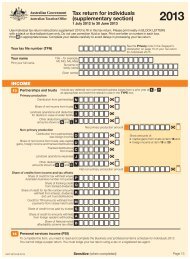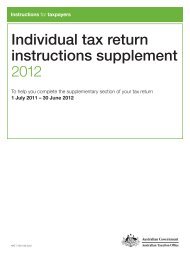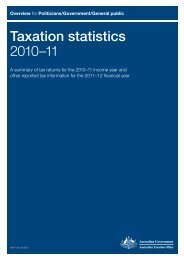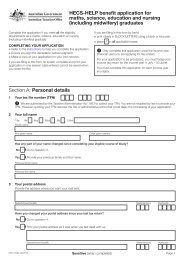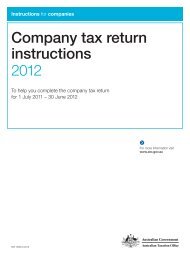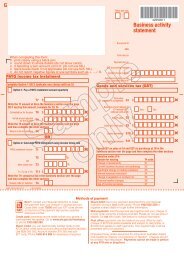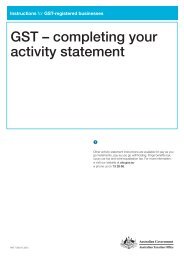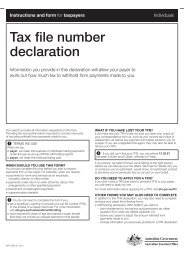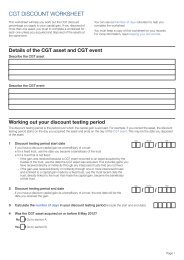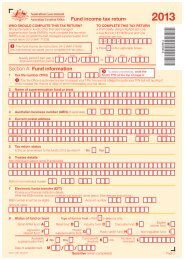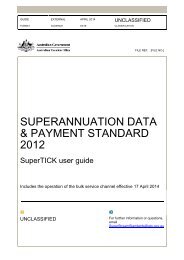Guide to depreciating assets 2013 - Australian Taxation Office
Guide to depreciating assets 2013 - Australian Taxation Office
Guide to depreciating assets 2013 - Australian Taxation Office
Create successful ePaper yourself
Turn your PDF publications into a flip-book with our unique Google optimized e-Paper software.
Limited recourse debt arrangementsIf expenditure on a <strong>depreciating</strong> asset is financed or refinancedwholly or partly by limited recourse debt (including a notionalloan under certain hire purchase or instalment sale agreementsof goods), excessive deductions for capital allowances are<strong>to</strong> be included as assessable income. This will occur wherethe limited recourse debt terminates but has not been paid infull by the deb<strong>to</strong>r. Because the debt has not been paid in full,the capital allowance deductions allowed for the expenditureexceed the deductions that would be allowable if the unpaidamount of the debt was not counted as capital expenditureof the deb<strong>to</strong>r. Special rules apply in working out whether thedebt has been fully paid.If you are not sure what constitutes a limited recourse deb<strong>to</strong>r how <strong>to</strong> work out your adjustment <strong>to</strong> assessable income,contact us or your recognised tax adviser.Split or merged <strong>depreciating</strong> <strong>assets</strong>If you hold a <strong>depreciating</strong> asset that is split in<strong>to</strong> two or more<strong>assets</strong>, or a <strong>depreciating</strong> asset that is merged in<strong>to</strong> another<strong>depreciating</strong> asset, you are taken <strong>to</strong> have s<strong>to</strong>pped holding theoriginal <strong>depreciating</strong> asset and <strong>to</strong> have started holding the spli<strong>to</strong>r merged asset. However, a balancing adjustment event doesnot occur just because <strong>depreciating</strong> <strong>assets</strong> are split or merged.An example of splitting a <strong>depreciating</strong> asset is removing aCB radio from a truck. If you install the radio in another truckyou may be merging the two <strong>assets</strong> (radio and truck).After <strong>depreciating</strong> <strong>assets</strong> are split or merged, each new assetmust satisfy the definition of a <strong>depreciating</strong> asset if the UCArules are <strong>to</strong> apply <strong>to</strong> it. For each <strong>depreciating</strong> asset you start<strong>to</strong> hold, you need <strong>to</strong> establish the effective life and cost.The first element of cost for each of the split or merged<strong>depreciating</strong> <strong>assets</strong> is:n a reasonable proportion of the adjustable value of theoriginal asset just before the split or merger, andn the same proportion of any costs of the split or merger.If a balancing adjustment event occurs <strong>to</strong> a merged or split<strong>depreciating</strong> asset (for example, if it is sold) the balancingadjustment amount is reduced:n <strong>to</strong> the extent the asset has been used for anon‐taxable purposen by any amount of the original <strong>depreciating</strong> asset that isreasonably attributable <strong>to</strong> use for a non-taxable purposeof the original <strong>depreciating</strong> asset before the split or merger.This reduction is not required if the <strong>depreciating</strong> asset ismining, quarrying or prospecting rights or information,provided certain activity tests are satisfied.Foreign currency gains and lossesIf you sell a <strong>depreciating</strong> asset in foreign currency, thetermination value of the asset is converted <strong>to</strong> <strong>Australian</strong>currency at the exchange rate applicable when you s<strong>to</strong>ppedholding the asset. Under the forex provisions, you maymake a foreign currency gain or loss if the <strong>Australian</strong> dollarvalue of the foreign currency when received differs from the<strong>Australian</strong> dollar value of the termination value. Any realisedforeign currency gain or loss on the transaction is included inassessable income or allowed as a deduction, respectively.If the TOFA rules apply <strong>to</strong> you, then the following may differ:n the method that you use <strong>to</strong> calculate your foreign currencygain or loss, andn the first element of the <strong>depreciating</strong> asset’s cost.For more information about the TOFA rules, see <strong>Guide</strong> <strong>to</strong> thetaxation of financial arrangements (TOFA) rules in <strong>Taxation</strong> offinancial arrangements (TOFA) at a<strong>to</strong>.gov.au/<strong>to</strong>faLOW-VALUE POOLSFrom 1 July 2000, an optional low-value pooling arrangementfor plant was introduced. It applied <strong>to</strong> certain plant costingless than $1,000 or having an undeducted cost of less than$1,000. Such plant could be allocated <strong>to</strong> a low-value pool anddepreciated at statu<strong>to</strong>ry rates.The UCA adopts most of the former rules for a low-value pool.From 1 July 2001, the decline in value of certain <strong>depreciating</strong><strong>assets</strong> can be worked out through a low-value pool.Transitional rules apply so that a low-value pool created before1 July 2001 continues and is treated as if it were createdunder the UCA. The closing balance of the pool worked outunder the former rules is used <strong>to</strong> start working out the declinein value of the <strong>depreciating</strong> <strong>assets</strong> in the pool under the UCA.Under the UCA, you can allocate low-cost <strong>assets</strong> andlow‐value <strong>assets</strong> <strong>to</strong> a low-value pool.A low-cost asset is a <strong>depreciating</strong> asset whose cost is lessthan $1,000 (after GST credits or adjustments) as at the endof the income year in which you started <strong>to</strong> use it, or had itinstalled ready for use, for a taxable purpose.A low-value asset is a <strong>depreciating</strong> asset:n that is not a low-cost assetn that has an opening adjustable value for the current yearof less than $1,000, andn for which you used the diminishing value method <strong>to</strong> workout any deductions for decline in value for a previousincome year.The decline in value of an asset that you hold jointly withothers is worked out on the cost of your interest in the asset.This means that if you hold an asset jointly and the cost ofyour interest in the asset or the opening adjustable valueof your interest is less than $1,000, you can allocate yourinterest in the asset <strong>to</strong> your low-value pool; see Jointly held<strong>depreciating</strong> <strong>assets</strong> on page 15.22 a<strong>to</strong>.gov.au GUIDE TO DEPRECIATING ASSETS <strong>2013</strong>



